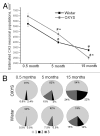Senescence-accelerated OXYS rats: a model of age-related cognitive decline with relevance to abnormalities in Alzheimer disease
- PMID: 24552807
- PMCID: PMC3984313
- DOI: 10.4161/cc.28255
Senescence-accelerated OXYS rats: a model of age-related cognitive decline with relevance to abnormalities in Alzheimer disease
Abstract
Senescence-accelerated OXYS rats are an experimental model of accelerated aging that was established from Wistar stock via selection for susceptibility to cataractogenic effects of a galactose-rich diet and via subsequent inbreeding of highly susceptible rats. Currently, we have the 102nd generation of OXYS rats with spontaneously developing cataract and accelerated senescence syndrome, which means early development of a phenotype similar to human geriatric disorders, including accelerated brain aging. In recent years, our group found strong evidence that OXYS rats are a promising model for studies of the mechanisms of brain aging and neurodegenerative processes similar to those seen in Alzheimer disease (AD). The manifestation of behavioral alterations and learning and memory deficits develop since the fourth week of age, i.e., simultaneously with first signs of neurodegeneration detectable on magnetic resonance imaging and under a light microscope. In addition, impaired long-term potentiation has been demonstrated in OXYS rats by the age of 3 months. With age, neurodegenerative changes in the brain of OXYS rats become amplified. We have shown that this deterioration happens against the background of overproduction of amyloid precursor protein (AβPP), accumulation of β-amyloid (Aβ), and hyperphosphorylation of the tau protein in the hippocampus and cortex. The development of AMD-like retinopathy in OXYS rats is also accompanied by increased accumulation of Aβ in the retina. These published data suggest that the OXYS strain may serve as a spontaneous rat model of AD-like pathology and could help to decipher the pathogenesis of AD.
Keywords: Alzheimer disease; brain aging; senescence-accelerated OXYS rats.
Figures





Similar articles
-
[The senescence-accelerated oxys rats--a genetic model of premature aging and age-dependent degenerative diseases].Adv Gerontol. 2014;27(2):336-40. Adv Gerontol. 2014. PMID: 25306668 Review. Russian.
-
Alzheimer's disease-like pathology in senescence-accelerated OXYS rats can be partially retarded with mitochondria-targeted antioxidant SkQ1.J Alzheimers Dis. 2014;38(3):681-94. doi: 10.3233/JAD-131034. J Alzheimers Dis. 2014. PMID: 24047616
-
Genes of susceptibility to early neurodegenerative changes in the rat retina and brain: analysis by means of congenic strains.BMC Genet. 2016 Dec 22;17(Suppl 3):153. doi: 10.1186/s12863-016-0461-7. BMC Genet. 2016. PMID: 28105932 Free PMC article.
-
Beneficial effects of melatonin in a rat model of sporadic Alzheimer's disease.Biogerontology. 2015 Jun;16(3):303-16. doi: 10.1007/s10522-014-9547-7. Epub 2014 Dec 17. Biogerontology. 2015. PMID: 25515660
-
SkQ1 as a Tool for Controlling Accelerated Senescence Program: Experiments with OXYS Rats.Biochemistry (Mosc). 2022 Dec;87(12):1552-1562. doi: 10.1134/S0006297922120124. Biochemistry (Mosc). 2022. PMID: 36717446 Review.
Cited by
-
Senescence in the pathogenesis of age-related macular degeneration.Cell Mol Life Sci. 2020 Mar;77(5):789-805. doi: 10.1007/s00018-019-03420-x. Epub 2020 Jan 2. Cell Mol Life Sci. 2020. PMID: 31897543 Free PMC article. Review.
-
Precocious Alterations of Brain Oscillatory Activity in Alzheimer's Disease: A Window of Opportunity for Early Diagnosis and Treatment.Front Cell Neurosci. 2015 Dec 21;9:491. doi: 10.3389/fncel.2015.00491. eCollection 2015. Front Cell Neurosci. 2015. PMID: 26733816 Free PMC article. Review.
-
Adenylyl cyclase 2 expression and function in neurological diseases.CNS Neurosci Ther. 2024 Jul;30(7):e14880. doi: 10.1111/cns.14880. CNS Neurosci Ther. 2024. PMID: 39073001 Free PMC article. Review.
-
Postnatal Maturation of the Blood-Brain Barrier in Senescence-Accelerated OXYS Rats, Which Are Prone to an Alzheimer's Disease-like Pathology.Int J Mol Sci. 2023 Oct 27;24(21):15649. doi: 10.3390/ijms242115649. Int J Mol Sci. 2023. PMID: 37958635 Free PMC article.
-
Emerging Pharmacological Targets for the Treatment of Nonalcoholic Fatty Liver Disease, Insulin Resistance, and Type 2 Diabetes.Annu Rev Pharmacol Toxicol. 2019 Jan 6;59:65-87. doi: 10.1146/annurev-pharmtox-010716-104727. Annu Rev Pharmacol Toxicol. 2019. PMID: 30625285 Free PMC article. Review.
References
Publication types
MeSH terms
Substances
LinkOut - more resources
Full Text Sources
Other Literature Sources
Medical
Molecular Biology Databases
